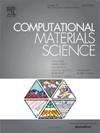Virtual texture analysis to understand microstructure effects on deformation twinning and detwinning behavior in BCC metals
IF 3.1
3区 材料科学
Q2 MATERIALS SCIENCE, MULTIDISCIPLINARY
引用次数: 0
Abstract
Understanding and predicting deformation twinning contributions to plastic deformation in BCC metals has been a long-standing challenge due to the interplay with dislocation slip and non-Schmid effects that render an asymmetry under tension and compression. This paper uses molecular dynamics simulations to understand the effect of unloading and grain orientation on deformation twinning in a nanocrystalline Fe (nc-Fe) system as a model BCC metal. The nc-Fe system is loaded under uniaxial stress tension and compression to understand the effect of grain orientation (Schmid effects) on deformation twinning behavior and the tension/compression asymmetry (non-Schmid effects). A new virtual texture analysis “VirTex” tool is used to understand the role of grain orientation on the nucleation of twins and their contributions to the observed stress–strain response. For certain grain orientations, the twinnability is observed to be different in tension and compression. In addition, the flow stress accommodation from twins in certain grains is observed to be different in tension and compression and different from that for the grains. Subsequent unloading leads to detwinning in the deformed microstructures, where the extent of detwinning depends on the strain from which the system is unloaded and on the morphology of the twin. Finally, the simulations are carried out to analyze the role of the Schmid factor on the twinnability and asymmetry in tension and compression.

求助全文
约1分钟内获得全文
求助全文
来源期刊

Computational Materials Science
工程技术-材料科学:综合
CiteScore
6.50
自引率
6.10%
发文量
665
审稿时长
26 days
期刊介绍:
The goal of Computational Materials Science is to report on results that provide new or unique insights into, or significantly expand our understanding of, the properties of materials or phenomena associated with their design, synthesis, processing, characterization, and utilization. To be relevant to the journal, the results should be applied or applicable to specific material systems that are discussed within the submission.
 求助内容:
求助内容: 应助结果提醒方式:
应助结果提醒方式:


